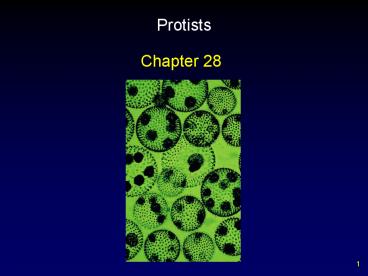Protists PowerPoint PPT Presentation
1 / 21
Title: Protists
1
Protists
- Chapter 28
2
Classifying Protists
- Protists are the most diverse of the four
kingdoms in the domain Eukarya. - artificial group of convenience
- single-celled organisms
- little consensus about classification
3
Protist Classification
4
Endosymbiosis
- Theory of endosymbiosis proposes that
mitochondria originated as symbiotic, aerobic
bacteria. - Each mitochondrion has its own genome in a
circular, closed molecule of DNA. - divide by simple fission
- directed by nuclear genes
5
Theory of Endosymbiosis
6
General Biology of the Protists
- Cell surface
- possess varied array of cell surfaces
- Locomotor organelles
- chiefly flagellar rotation or pseudopodial
movement - Cyst formation
- dormant form of a cell with resistant outer
covering in which metabolism is essentially shut
down
7
General Biology of the Protists
- Nutrition
- employ all forms but chemoautotrophic
- phototrophs
- heterotrophs
- phagotrophs - visible food particles
- osmotrophs - food in soluble form
8
General Biology of the Protists
- Reproduction
- typically reproduce asexually
- binary fission - equal halves
- budding - progeny cell smaller
- sexual reproduction in times of stress
9
Euglenoids
10
Euglenozoa
- Kinetoplastids
- Trypanosomes are kinetoplastids that cause many
serious human diseases. - African sleeping sickness
- Chagas
11
Alveolata
- Dinoflagellates
- distinctive flagella, protective coats, and
biochemistry - reproduce primarily by asexual cell division
- responsible for red tides
12
Alveolata
- Apicomplexes
- spore-forming animal parasites
- malarial parasite - Plasmodium
13
Alveolata
- Ciliates
- most feature large numbers of cilia form vacuoles
to ingest food and regulate water balance - Paramecium
14
Stramenopila and Rhodophyta
- Stramenopila
- includes brown algae, diatoms, and oomycetes
- brown algae - conspicuous seaweeds
- alternation of generations
- diatoms (phylum Chrysophyta) - photosynthetic,
unicellular organisms with double shells of
opaline silica
15
Stramenopila and Rhodophyta
- Rhodophyta
- Red algae range in size from microscopic to very
large. - origin a source of controversy
- tentatively treated as a sister clade of green
algae (Chlorophyta)
16
Chlorophyta
- Green algae are the ancestors of the plant
kingdom. - extensive fossil record dating back 900 million
years - mostly aquatic
- Chlamydomonas well-known genus
- probably represents primitive state
- Chlorophyta did not give rise to land plants.
17
Chlamydomonas Life Cycle
18
Choanoflagellida
- Choanoflagellates are most like the common
ancestor of the sponges. - contain a single emergent flagellum surrounded by
a funnel-shaped, contractile collar
19
Amoebas
- contain pseudopods that can form at any point on
the cell body and can move in any direction - Phylum Actinopoda (radiolarians) secrete glassy
exoskeletons of silica.
20
Foraminifera
- heterotrophic marine protists with pore-studded
shells - complex life cycle with alternation between
haploid and diploid generations
21
Slime Molds

